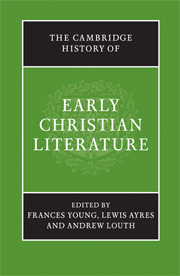Book contents
- Frontmatter
- PART ONE The Beginnings: The New Testament to Irenaeus
- PART TWO THE THIRD CENTURY
- PART THREE FOUNDATION OF A NEW CULTURE: FROM DIOCLETIAN TO CYRIL
- A LITERARY GUIDE
- 21 Classical genres in Christian guise; Christian genres in classical guise
- 22 Arnobius and Lactantius
- 23 Eusebius and the birth of church history
- 24 The fourth-century Alexandrians: Athanasius and Didymus
- 25 Palestine: Cyril of Jerusalem and Epiphanius
- 26 The Cappadocians
- 27 Fourth-century Latin writers: Hilary, Victorinus, Ambrosiaster, Ambrose
- 28 Jerome and Rufinus
- 29 Augustine
- 30 John Chrysostom and the Antiochene School to Theodoret of Cyrrhus
- 31 Cyril of Alexandria
- 32 Hagiography
- 33 Ephrem and the Syriac Tradition
- 34 The literature of the monastic movement
- 35 Women and words: texts by and about women
- 36 Conciliar records and canons
- B CONTEXT AND INTERPRETATION
- Bibliographies
- Index
- Map: The Roman Empire in the late fourth century AD"
- References
28 - Jerome and Rufinus
from A - LITERARY GUIDE
Published online by Cambridge University Press: 28 March 2008
- Frontmatter
- PART ONE The Beginnings: The New Testament to Irenaeus
- PART TWO THE THIRD CENTURY
- PART THREE FOUNDATION OF A NEW CULTURE: FROM DIOCLETIAN TO CYRIL
- A LITERARY GUIDE
- 21 Classical genres in Christian guise; Christian genres in classical guise
- 22 Arnobius and Lactantius
- 23 Eusebius and the birth of church history
- 24 The fourth-century Alexandrians: Athanasius and Didymus
- 25 Palestine: Cyril of Jerusalem and Epiphanius
- 26 The Cappadocians
- 27 Fourth-century Latin writers: Hilary, Victorinus, Ambrosiaster, Ambrose
- 28 Jerome and Rufinus
- 29 Augustine
- 30 John Chrysostom and the Antiochene School to Theodoret of Cyrrhus
- 31 Cyril of Alexandria
- 32 Hagiography
- 33 Ephrem and the Syriac Tradition
- 34 The literature of the monastic movement
- 35 Women and words: texts by and about women
- 36 Conciliar records and canons
- B CONTEXT AND INTERPRETATION
- Bibliographies
- Index
- Map: The Roman Empire in the late fourth century AD"
- References
Summary
Jerome obliged all future historians of Christian literature by compiling the first chronological list of Christian writers and their works, beginning with St Peter and ending with himself. His catalogue De Viris Illustribus (‘On Famous Men’) or De Scriptoribus Ecclesiasticis (‘On Ecclesiastical Writers’) was published in ‘the fourteenth year of the Emperor Theodosius’ (AD 392/3) when he was in his mid-forties and had been living for several years in Bethlehem. His principal generic model was a biobibliography of Roman literature by C. Suetonius Tranquillus (d. AD 160), while for his knowledge of ante-Nicene Christian literature he relied heavily on the Ecclesiastical History of Eusebius of Caesarea. Where Suetonius divided his subjects into separate sequences by profession (grammarians, rhetoricians, poets, etc.), Jerome makes one sequence of all who had ‘left something on record about the Holy Scriptures (de scripturis sanctis)’ (Vir. Ill. prol). And where Eusebius aimed to recall those ‘who in each generation were the ambassadors of the word of God either by speech (agraphos) or writing (dia sungrammaton)’ (HE I.I), he attends mainly to written performance. ‘Christian literature’, as he conceives and presents it for the first time, is defined in three ways: negatively as a class of writing distinct from the corpus of pagan literature (litterae gentiles), positively as an elaboration of the Bible (in the first instance, of the Old Testament), and practically as the life’s work of Jerome himself.
- Type
- Chapter
- Information
- The Cambridge History of Early Christian Literature , pp. 318 - 327Publisher: Cambridge University PressPrint publication year: 2004
References
- 1
- Cited by

